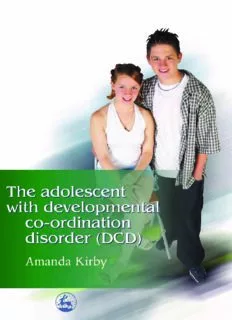
The Adolescent with Developmental Co-ordination Disorder (DCD) PDF
Preview The Adolescent with Developmental Co-ordination Disorder (DCD)
The Adolescent with Developmental Co-ordination Disorder (DCD) of relatedinterest Stephen Harris in Trouble ADyspraxicDramainSeveralClumsyActs TimNichol ISBN1843101343 Developmental Coordination Disorder HintsandTipsfortheActivitiesof DailyLiving MorvenF.Ball ISBN1843100908 Freaks, Geeks and Asperger Syndrome AUserGuidetoAdolescence LukeJackson ForewordbyTonyAttwood ISBN1843100983 Asperger Syndrome in Adolescence LivingwiththeUps,theDownsandThingsinBetween EditedbyLianeHollidayWilley ForewordbyLukeJackson ISBN1843107422 Haze AnAspergerNovel KathyHoopmann ISBN184310072X How to Help a Clumsy Child StrategiesforYoungChildrenwithDevelopmentalMotorConcerns LisaA.Kurtz ISBN1843107546 The Adolescent with Developmental Co-ordination Disorder (DCD) Amanda Kirby Foreword by Professor David Sugden Jessica Kingsley Publishers London and New York ExtractreproducedwithpermissionfromtheDiagnosticandStatistical ManualofMentalDisorders,TextRevision,Copyright©2000American PsychiatricAssociation. Allrightsreserved.Nopartofthispublicationmaybereproducedinanymaterial form(includingphotocopyingorstoringitinanymediumbyelectronicmeansand whetherornottransientlyorincidentallytosomeotheruseofthispublication) withoutthewrittenpermissionofthecopyrightownerexceptinaccordancewith theprovisionsoftheCopyright,DesignsandPatentsAct1988orundertheterms ofalicenceissuedbytheCopyrightLicensingAgencyLtd,90TottenhamCourt Road,London,EnglandW1P9HE.Applicationsforthecopyrightowner’swritten permissiontoreproduceanypartofthispublicationshouldbeaddressedtothe publisher. Warning:Thedoingofanunauthorisedactinrelationtoacopyrightworkmay resultinbothacivilclaimfordamagesandcriminalprosecution. TherightofAmandaKirbytobeidentifiedasauthorofthiswork hasbeenassertedbyherinaccordancewiththeCopyright,Designs andPatentsAct1988. (cid:1) Allpagesmarked maybephotocopiedfortrainingpages,butmaynotbe reproducedinotherformswithoutthepermissionofthepublisher. FirstpublishedintheUnitedKingdomin2004 byJessicaKingsleyPublishersLtd 116PentonvilleRoad LondonN19JB,England and 29West35thStreet,10thfl. NewYork,NY10001-2299,USA www.jkp.com Copyright©AmandaKirby2004 Libraryof CongressCataloginginPublicationData ACIPcatalogrecordforthisbookisavailablefromtheLibraryofCongress BritishLibraryCataloguinginPublicationData ACIPcataloguerecordforthisbookisavailablefromtheBritishLibrary ISBN1843101785 PrintedandBoundinGreatBritainby AthenaeumPress,Gateshead,TyneandWear Contents ACKNOWLEDGEMENTS 6 Foreword 7 Professor David Sugden, University of Leeds Introduction 9 1 What is Developmental Co-ordination Disorder? 12 2 Supporting the Adolescent into Adulthood 21 3 How Does Puberty Affect the Adolescent with DCD? 29 4 Living Together as a Family 36 5 Social and Emotional Impact of Adolescence 44 6 Raising Self-esteem and Improving Social Skills 59 7 Transition 69 8 Strategies for Secondary School 86 9 Moving On and Moving Out 117 REFERENCES 133 USEFULADDITIONALREADING 134 USEFULADDRESSES 136 SUBJECTINDEX 138 NAMEINDEX 143 Acknowledgements Writing a book takes time, and time with some people that I drive mad,andtimeawayfromothersIshouldbespendingtimewith.I have to thank both groups for surviving living with me. Thanks to the team at The Dyscovery Centre, without their support there would not be a book in the first place. Special thanks to Val who has tirelessly edited the book and sorted me out as well. Thanks to my family and my long suffering husband and children,especiallyAndrew.Withouthisinsightandunderstanding of his own challenges, I would not have written this at all. Foreword Thisbookexaminesanareahithertoalmostignoredbytheliterature:that of the adolescent with developmental co-ordination disorder (DCD). Thelast20yearshavewitnessedagreatincreasenotonlyintheamount of literatureassociatedwithDCDbutalsointhevisibilityandprofileit hasacquiredinprofessionalandpopulararenas.Itisnowrecognisedasa developmental disorder alongside dyslexia, autistic spectrum disorder andattentiondeficitdisorder.However,thevastmajorityofthisattention has been paid to the age group roughly 5 to 12 years of age with little addressing the needs of the adolescent. The pubertal spurt occurs at aroundthetimeofadolescenceandinvolvesthechildingreatchangesin their physical makeup, with anthropometric changes, together with the physiological developments modifying and significantly altering the child’s capacity to perform skilled purposeful actions. Sometimes the increase in a child’s strength at this time is a help to overcome a lack of skill, but at other times the changes in body resources are so profound that a child with difficulties may see these difficulties compounded. In addition,thesocialandemotionalcontextintowhichtheadolescenthas nowmovedprobablyrequiresadifferentapproachtointerventionfrom that which had been previously employed when the child was younger. At a younger age, the child is more dependent on significant others to makedecisionsabouthisorherlife;itisalwaysadvisableforthechildto beinvolvedinthesedecisions,butadultsareoftenthe‘choicepresenters’. Duringandafteradolescence,theyoungpersonisstrivingformoreinde- pendencewhilewantingasecurityfromwhichtheycanmaketheirown decisions; consequently, any form of intervention must take this into account. 7 8 THEADOLESCENTWITHDEVELOPMENTALCO-ORDINATIONDISORDER(DCD) Themostcrucialcontributiontointerventionwithadolescentswith DCDisarecognitionthatitmustbepartof overallfunctionaldailylife andassuchitmustbeincontext.ThisbookbyAmandaKirbyfromthe Dyscovery Centre does just that. The recommendations are functional andthedifficultiesayoungpersonfacesareplacedinthecontextofdaily living. Thus there are chapters on ‘Living Together as a Family’, ‘Social and Emotional Impact of Adolescence’, ‘Raising Self-esteem and ImprovingSocialSkills’,aswellassuggestionsfor‘StrategiesforSecond- ary School’ and ‘Transition’. Dr Kirby has a strong background that allowshertowritewithauthorityfromanumberofpositions.Asisoften thecase,herinitialinterestcameaboutasaresultofpersonalexperience, whichtranslatedintotheformationoftheDyscoveryCentre.Thisestab- lishmenthas,duringthelastfiveyears,assessedandprovidedhelp,advice andguidancetoseveralhundredyoungpeoplewitharangeofdevelop- mentaldisabilitiesacrosstheagerange.Finally,DrKirbyiswellversedin theresearchliteratureandthusabooksuchasthisistheessenceofwhat has come to be described as ‘evidence based practice’. The book is a welcomeadditiontothefield,andwillappealandbeofgreatbenefitto parents, professionals and all who are interested in young persons who present a range of developmental disorders. ProfessorDavidSugden, Universityof Leeds Introduction In the past few years there has been increased recognition of develop- mentalco-ordinationdisorder(DCD)alsoknownasdyspraxia,andother related specific learning difficulties such as dyslexia, ADHD (attention deficit hyperactivity disorder), and Asperger’s Syndrome (a social and communicationdisorder).UntilrecentlyDCDwasthoughtofasprimar- ily a children’s problem. The development of organisations such as DyspraxiaFoundationintheUK,andmorerecentlyDANDA(Develop- mentAdultNeurodiversityAssociation)alongwithincreasingresearchin theareaisanacknowledgementthatsomechildrenwillcontinuetohave difficultiesintoadulthood.Thisisalsotrueofotherdevelopmentaldisor- ders,thatuntilrecentlywereseenaschildren’sproblemsthatwouldeven- tuallydisappear.Atthepresenttime,theonethingthatmoreoftendisap- pears is specialist services for the adolescent and young adult. Ifyouarereadingthisbook,youareeitherlikelytoknowanadoles- cent with dyspraxia or DCD or are teaching or working with children thatmayhavesomedifficulties.Youareprobablyawareof theproblems tosomeextent.Howeverforsomechildrentheirdifficultiesmayremain hidden into adulthood and present themselves as individuals with negativebehaviourtowardsothers,depressivesymptomsorjustfeelthat they are a failure rather than an individual that learns differently. One hundred years ago we knew very little about co-ordination difficulties and referred to individuals as clumsy and stupid, but in the 2000s with awareness and greater knowledge, we certainly should be trying to identifyandsupportindividualsthroughtheirlearningyears.Wehavea responsibility as parents and professionals to ensure that we provide learning in an environment that is conducive to all children not just a 9
Description: